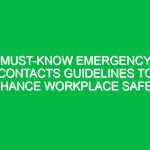“`html
Essential Tips for Embracing Change in the Workplace Safely
Good morning team,
Today, we’re going to discuss an important topic: Essential Tips for Embracing Change in the Workplace Safely. Change is a constant in our professional lives, whether it’s adopting new technologies, altering processes, or adjusting to a new team structure. Understanding how to navigate these changes safely is crucial, not just for your own wellbeing but for the Safety of everyone around you.
Why is this topic so important? Because embracing change can often come with risks. When we don’t handle change correctly, it can lead to confusion, mistakes, and even accidents. So let’s take a closer look at how we can prepare ourselves for these transitions while keeping safety at the forefront of our minds.
Understanding Essential Tips for Embracing Change in the Workplace Safely
The concept of embracing change involves being open to new ideas, processes, and structures. In the context of Workplace Safety, this means understanding how these changes can affect your daily operations and the overall safety Environment. It’s important to recognize that while change can lead to improvements, it can also introduce new Hazards if not managed properly.
Many employees may believe that as long as they follow existing protocols, they are safe from harm during changes. However, this misconception can lead to complacency. Each change can bring about unique risks that require careful assessment and adaptation of our safety practices.
Key Hazards, Risks, and Safety Considerations
As we embrace change, we must also be aware of the specific hazards and risks that can arise:
- Communication Breakdown: Changes in procedures or processes can lead to confusion if not communicated clearly, resulting in mistakes or accidents.
- Inadequate Training: When new systems or tools are introduced, failing to provide adequate training can lead to improper usage, which is a significant safety risk.
- Resistance to Change: Employees who are resistant to change may not follow new safety protocols, leading to unsafe practices.
- Increased Workload: During transitions, workloads can increase, leading to fatigue and decreased attention to safety.
Ignoring these risks can have real-world consequences, such as workplace injuries, which can affect not only the individual but the entire team and organization. It’s crucial to be proactive in identifying and addressing these hazards.
Best Practices, Procedures, & Actionable Advice
Now that we understand the potential hazards, let’s explore Best Practices for safely embracing change:
1. Communicate Openly
Clear communication is key during any transition. Make sure to:
- Discuss upcoming changes in team meetings.
- Provide written documentation outlining new procedures.
- Encourage questions and feedback to clarify any uncertainties.
2. Provide Comprehensive Training
Ensure that all employees receive thorough training on any new systems, tools, or processes. This includes:
- Hands-on demonstrations.
- Access to user manuals and online resources.
- Periodic refresher courses to keep skills sharp.
3. Involve Employees in the Process
Involving employees in the change process can alleviate anxiety and foster a sense of ownership. Consider:
- Forming focus groups to gather input on changes.
- Allowing employees to suggest improvements or share past experiences related to changes.
4. Monitor and Evaluate
After implementing changes, monitor the situation closely. This includes:
- Gathering feedback from employees about the new processes.
- Observing any changes in safety incidents or near misses.
- Making adjustments to protocols as necessary based on feedback and observations.
5. Maintain a Positive Attitude
Change can be challenging, but maintaining a positive outlook can help. Encourage team members to:
- Share success stories related to past changes.
- Recognize the Benefits that come with new systems or processes.
Regulations, Standards, and Compliance
When embracing change, it’s vital to adhere to relevant safety Regulations and Standards, such as OSHA or ISO regulations. Compliance is critical because it:
- Ensures a safe working environment.
- Protects employees from harm.
- Reduces liability for the organization.
Make sure to familiarize yourself with any new regulations that may affect your work during changes. Compliance not only protects you but also helps create a culture of safety within the organization.
Employee Engagement & Discussion
Now, let’s open the floor for discussion. Here are some questions to consider:
- What safety challenges have you encountered when changes were implemented in the past?
- How do you feel about the changes we are currently experiencing?
- What suggestions do you have for improving our approach to safety during transitions?
Your feedback is invaluable in helping us create a safer workplace. Let’s work together to ensure that we embrace change in a way that prioritizes our health and safety.
Conclusion & Key Takeaways
To wrap up, here are the key takeaways from today’s Toolbox Talk on Essential Tips for Embracing Change in the Workplace Safely:
- Embrace open communication during transitions.
- Provide thorough training to mitigate risks.
- Involve employees in the change process for greater acceptance.
- Monitor and evaluate the effectiveness of new practices.
- Stay compliant with safety regulations to protect everyone.
Remember, change is an opportunity for growth, and when we approach it with a focus on safety, we can navigate transitions smoothly and effectively. Thank you all for your attention and your commitment to keeping our workplace safe.
“`


